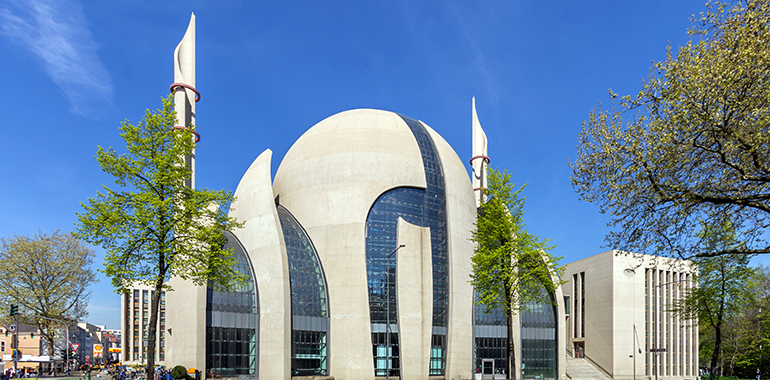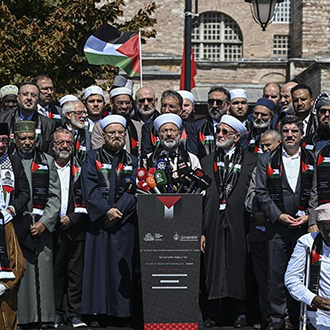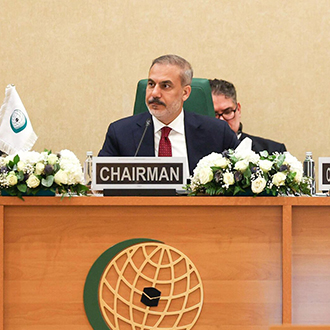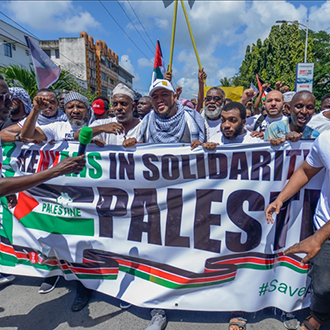Hitler’s rise to power in 1933 marked the beginning of a period of significant hardship for the Muslim community in Germany. This is because Amin al-Husseini (d. 1974), the Mufti of al-Quds under British rule, took refuge in Germany, and his activities supporting the NSU government and his antisemitic discourses tarnished the public perception of Muslims in post-war Germany. This negative perception that emerged after World War II led to the closure of numerous Islamic communities within the country.
In the immediate aftermath of World War II, a significant Muslim presence in Germany remained largely absent until the mid-1950s. This changed with the arrival of the Pakistani Ahmadiyya Muslim Community, which established a center in Hamburg in 1955. Subsequently, Iranian merchants constructed a mosque in the same city in 1961. Additionally, groups of primarily Arab Muslim students and academics began forming religious organizations and associations in cities like Munich and Aachen.
Driven by the need to rebuild post-war Germany and address labor shortages in its industries, the German government requested workers from Muslimmajority countries, particularly from Türkiye, in the early 1960s. Initially seen as temporary guest workers, these people made long-term plans to stay in Germany, bringing their spouses and children with them until the 1980s, creating a permanent Muslim community in the country.
Apart from the difficulties in meeting the social and cultural needs of Muslim immigrants, a crucial challenge faced by Muslim immigrants was the struggle to live and preserve their language and religion, core elements of their identity. In this context, the search for places of gathering and worship began. Initially, repurposed old factory buildings and apartments, known as “Hinterhofmoschee” (Backyard Mosques), were rented or purchased to provide basic gathering and worship spaces for the growing community. These makeshift structures served as focal points for the first generation of immigrants to congregate and build a sense of community. Towards the mid-90s, it became possible to build mosques, and educational and cultural centers by obtaining zoning permits for projects in the style of classical Islamic architecture with domed foundations and minarets.
Between 1970 and 1980, this congregationalization led to the formation of congregational associations such as the Union of Islamic Cultural Centers, the Islamic Federation, and the Central Council of Muslims in Germany, which is composed mostly of Arab Muslims. Among these associations, DITIB (Turkish Islamic Union for Religious Affairs) was founded in 1984 by the merger of 135 independent mosque associations, many of which were served by imams sent by the Presidency of Religious Affairs of Türkiye.
Recognizing the need for a unified discourse and action, DITIB, the Islamrat, which is primarily composed of the Islamic Society National Vision, the Central Council of Muslims in Germany (ZMD), and the Union of Islamic Cultural Centers (VIKZ) joined forces in 2007 to establish the Coordination Council of Muslims in Germany (KRM). This organization aims to create a unity of discourse and action on issues of concern to Muslims and issues discussed in German public opinion. In 2019, the KRM welcomed two additional members: the Union of Albanian Islamic Centers in Germany (UIAZD) and the Central Council of Moroccans in Germany (ZRMD), expanding its membership to six organizations. However, in October 2023, the Union of Islamic Cultural Centers (VIKZ) decided to leave the KRM.
The Federal Republic of Germany’s secular structure maintains ongoing interaction between the state and established religious communities, despite the separation of religion and state. This interaction takes the form of “state agreements,” legally recognizing religious communities as autonomous entities with public legal personality. In Germany, which has a federal political structure, Islamic communities, particularly DITIB, started to establish state associations in 2009 to obtain public legal personality rights on a state-by-state basis, like other established Christian, Jewish, and free-standing religious community groups. These efforts have yielded results in some states, like Hamburg, Lower Saxony, and Bremen, where state agreements were signed with the Shura, which includes DITIB and other religious communities, and the Union of Islamic Cultural Centers, effectively granting them recognition as official religious communities. In other states such as Hesse, Baden-Württemberg, Berlin, and Rhineland-Palatinate, while formal agreements have not been signed, the state governments cooperate with Islamic communities on matters like Islamic religious education, creating a de facto partnership.
A pivotal moment in the official recognition of the Muslim presence in Germany came with the 9th President of Germany, Christian Wulff’s statement, “Islam belongs to Germany.” While this statement sparked public debate, it also served as a highlevel acknowledgment of the Muslim reality within the country. Recognizing the need for homegrown Islamic expertise, the German Scientific Council adopted an advisory decision in 2010 to establish Islamic Theology Centers in German universities in order to train Islamic theologians and religious education teachers in Germany. Following this decision, Islamic Theology Centers have been established at several universities, including Tübingen, Münster, Osnabrück, Erlangen, Berlin Humboldt, and Paderborn. Preparations and negotiations are currently underway for the opening of a new center at the University of Koblenz. In these theological centers, religious advisory boards, which include representatives of Islamic communities, have a partial say in determining the curriculum and appointing lecturers.
It is important to acknowledge the proactive role DITIB and the Presidency of Religious Affairs of Türkiye played in anticipating the need for Islamic theological training within Germany. Notably, they recognized this requirement even before the German state itself took concrete steps. Their foresight led to the establishment of the Chair of Islamic Theology at Frankfurt Goethe University in 2002, effectively pioneering the field of Islamic theological centers that would emerge in Germany after 2010. Since 2006, the Presidency of Religious Affairs of Türkiye has initiated the International Theology Program, enabling young people born and raised in Germany to study theology at prestigious universities in Türkiye. Hundreds of graduates from this program are now serving in various capacities as religious officials, academics, educators, spiritual guides, and even administrators in the management and administrative units of the DITIB Federal Union in Europe and on different continents of the world.
The relations between DITIB and other Islamic communities, especially DITIB, which aims to obtain the right to public legal personality, with the state fluctuates based on the prevailing conjunctural, political, and social developments. However, it is a fact that DITIB is the largest and most important actor in Germany, addressing the widest audience with 858 mosque associations, 1,200 religious officials, and 24,000 honorary and volunteer employees.
Over the past six decades, the Muslim population in Germany has grown to approximately 5.6 million individuals. This population has demonstrably integrated into German society, establishing a network of roughly 2.500 mosque associations and educational and cultural institutions. Furthermore, Muslim entrepreneurs have created employment opportunities for approximately 500.000 individuals, and human resources trained within the Muslim community now contribute their skills and expertise across various levels of German society. This reality was acknowledged by the incumbent Federal President of Germany, Frank-Walter Steinmeier, who stated that “Islam has now taken root in Germany.”









